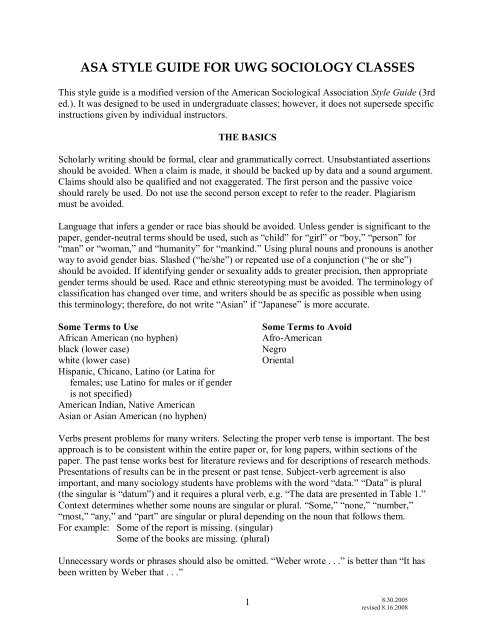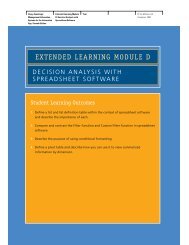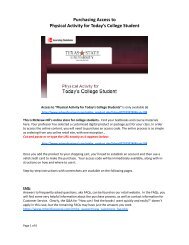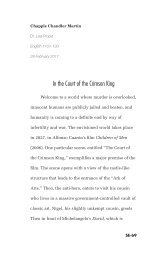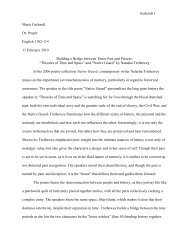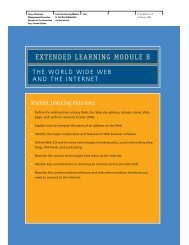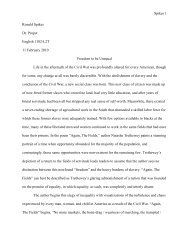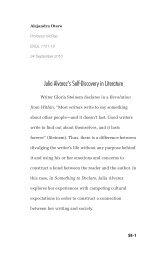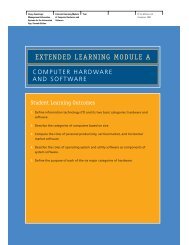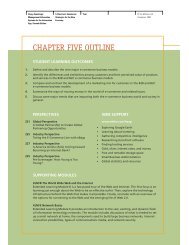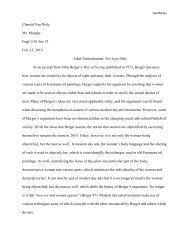Sample ASA material - McGraw-Hill Learning Solutions
Sample ASA material - McGraw-Hill Learning Solutions
Sample ASA material - McGraw-Hill Learning Solutions
Create successful ePaper yourself
Turn your PDF publications into a flip-book with our unique Google optimized e-Paper software.
<strong>ASA</strong> STYLE GUIDE FOR UWG SOCIOLOGY CLASSES<br />
This style guide is a modified version of the American Sociological Association Style Guide (3rd<br />
ed.). It was designed to be used in undergraduate classes; however, it does not supersede specific<br />
instructions given by individual instructors.<br />
THE BASICS<br />
Scholarly writing should be formal, clear and grammatically correct. Unsubstantiated assertions<br />
should be avoided. When a claim is made, it should be backed up by data and a sound argument.<br />
Claims should also be qualified and not exaggerated. The first person and the passive voice<br />
should rarely be used. Do not use the second person except to refer to the reader. Plagiarism<br />
must be avoided.<br />
Language that infers a gender or race bias should be avoided. Unless gender is significant to the<br />
paper, gender-neutral terms should be used, such as ―child‖ for ―girl‖ or ―boy,‖ ―person‖ for<br />
―man‖ or ―woman,‖ and ―humanity‖ for ―mankind.‖ Using plural nouns and pronouns is another<br />
way to avoid gender bias. Slashed (―he/she‖) or repeated use of a conjunction (―he or she‖)<br />
should be avoided. If identifying gender or sexuality adds to greater precision, then appropriate<br />
gender terms should be used. Race and ethnic stereotyping must be avoided. The terminology of<br />
classification has changed over time, and writers should be as specific as possible when using<br />
this terminology; therefore, do not write ―Asian‖ if ―Japanese‖ is more accurate.<br />
Some Terms to Use<br />
African American (no hyphen)<br />
black (lower case)<br />
white (lower case)<br />
Hispanic, Chicano, Latino (or Latina for<br />
females; use Latino for males or if gender<br />
is not specified)<br />
American Indian, Native American<br />
Asian or Asian American (no hyphen)<br />
1<br />
Some Terms to Avoid<br />
Afro-American<br />
Negro<br />
Oriental<br />
Verbs present problems for many writers. Selecting the proper verb tense is important. The best<br />
approach is to be consistent within the entire paper or, for long papers, within sections of the<br />
paper. The past tense works best for literature reviews and for descriptions of research methods.<br />
Presentations of results can be in the present or past tense. Subject-verb agreement is also<br />
important, and many sociology students have problems with the word ―data.‖ ―Data‖ is plural<br />
(the singular is ―datum‖) and it requires a plural verb, e.g. ―The data are presented in Table 1.‖<br />
Context determines whether some nouns are singular or plural. ―Some,‖ ―none,‖ ―number,‖<br />
―most,‖ ―any,‖ and ―part‖ are singular or plural depending on the noun that follows them.<br />
For example: Some of the report is missing. (singular)<br />
Some of the books are missing. (plural)<br />
Unnecessary words or phrases should also be omitted. ―Weber wrote . . .‖ is better than ―It has<br />
been written by Weber that . . .‖<br />
8.30.2005<br />
revised 8.16.2008
FORMAT<br />
All text – including the title page, abstract, references and tables or figures – should be doublespaced<br />
and printed in Times New Roman 12. Margins should be set at 1.25-inch on all four<br />
sides. The paper should be stapled. The pages should be numbered.<br />
The title page (or cover sheet) should include the title of the paper, your name, the course title,<br />
the words ―University of West Georgia‖ and the date. This information should be arranged<br />
vertically.<br />
An abstract follows the title page. It should be one paragraph and approximately 150 words in<br />
length. Some instructors may not want an abstract. The title should appear on the top of this<br />
page.<br />
The body should begin on a new page, and the title should appear at the top of this page.<br />
References should begin on a separate page following the body of your paper. The word<br />
―References‖ should be centered at the top of the page.<br />
Each figure (chart, illustration, photograph) and table should be given a descriptive title. Tables<br />
should be numbered consecutively, as should figures. The title should be placed at the top. For<br />
the tables, headings should be written out, not abbreviated, for all columns and rows. If the figure<br />
or table is derived from a secondary source, the source should be listed at the bottom. According<br />
to the instructor‘s directions, figures and tables will be included in the body of the paper or<br />
located after the references. In all cases, an indication of the figure or table should be mentioned<br />
in the text, e.g., (See Table 1). See pages 9 and 10 for examples of figures and tables.<br />
CITATIONS IN THE TEXT<br />
Authors‘ last names and publication dates are included in all citations. Do not put<br />
punctuation between the names and the dates. Page numbers are also used if the reference is to<br />
specific passages or if it involves a direct quote. If a citation follows a direct quote at the end of a<br />
sentence, the period follows the citation, not the quotation. URL‘s are not used in citations.<br />
1. If the author‘s name is in the text, simply put the date of publication in parentheses, e.g., . . .<br />
according to Holland (2005).<br />
2. If the author‘s name is not in the text, put the name and date of publication in parentheses,<br />
e.g., . . . (Sawtell 2007).<br />
3. If the cited text has two authors, list both authors, e.g., . . . (Arrigo and Williams 2004).<br />
4. If the cited text has three authors, list all authors in the first citation and use the first author<br />
and ―et al.‖ in subsequent citations, e.g., (Jenks, Carter and Jenks 2007) becomes (Jenks et<br />
al. 2007) in later citations.<br />
2<br />
8.30.2005<br />
revised 8.16.2008
5. If the text being cited has more than three authors, use ―et al.‖ in all citations, e.g., in a study<br />
of short term treatment (Stone et al. 2004).<br />
6. Page numbers go after the publication date. A colon separates the date and the pages. Omit<br />
the space between the colon and the pages, e.g., ―. . . issues that arise in most courts‖ (Fuller<br />
2006:284).<br />
7. Use block quotation style for quotes of 50 words or more. This style is indented, and<br />
quotation marks are not used. If a page number follows the block quote a capital ―P.‖ is<br />
used, e.g., (P.57).<br />
8. A series of references should be alphabetized or put in chronological order (consistently<br />
throughout the paper) and separated by semicolons, e.g., . . . (Johnson 2007; Luken and<br />
Vaughan 2003a; Noori 2006).<br />
9. For works with organizational authorship or without an author, provide minimum<br />
identification, e.g., . . . (U.S. Bureau of the Census 2004).<br />
10. For citation of a reprint of an earlier version, include the earlier publication date in brackets<br />
prior to the recent version, e.g., . . . ([1899] 2003).<br />
11. If an organizational author or title is lengthy, use an abbreviated form in the citation, e.g. if<br />
the author is the American Sociological Association use <strong>ASA</strong> in the text citation.<br />
BOOKS<br />
REFERENCES<br />
References are arranged in alphabetical order by authors‘ last names.<br />
Double-space all references.<br />
Use hanging indentations of .5 inch.<br />
Use authors‘ first names and middle names or initials if they are provided. If the author<br />
uses initials instead of the surname, use initials also.<br />
If the date of publication is unknown, use ―N.d.‖<br />
If the publication has yet to appear, use ―Forthcoming.‖<br />
If an author has two or more publications, list them in the order in which they appeared,<br />
i.e., the earliest year first. Place the author‘s name in the first listing and use three em<br />
dashes and a period (———.) instead of the name in subsequent listings. If the<br />
publications are in the same year, the articles are listed alphabetically by title of article,<br />
and the letters ―a,‖ ―b,‖ ―c,‖ and so on are attached to the date. Do not consider the words<br />
―a,‖ ―an,‖ or ―the‖ when alphabetizing.<br />
Use an en dash to indicate a range of pages.<br />
Omit the state of publication if the city is New York.<br />
Put a colon between the title and subtitle.<br />
3<br />
8.30.2005<br />
revised 8.16.2008
Book – single author<br />
Last name, First name, Initials. Date of publication. Title of the Book in Italics. City of<br />
publication, postal initials for state of publication: Publisher. (For foreign publications<br />
use city and country instead of city and state.)<br />
Fuller, John Randolph. 2006. Criminal Justice: Mainstream and Crosscurrents. Upper Saddle<br />
River, NJ: Pearson Prentice-Hall.<br />
Book—two or more authors<br />
Last name, First name, Initial ―and‖ First name Initials Last name. Date of publication. Title of<br />
the Book in Italics. City of publication, postal initials for state of publication: Publisher.<br />
Arrigo, Bruce A. and Christopher R. Williams. 2004. Theory, Justice and Social Change:<br />
Theoretical Implications and Critical Applications. New York: Kluwer Academic<br />
Publishers.<br />
Note: If there are more then two authors, do not put a comma between the names of the next-tolast<br />
and the last author.<br />
Anonymous source<br />
1. Do not use the word ―Anonymous‖ to designate the author.<br />
2. If the author‘s name can be discerned from the work itself, put it in brackets.<br />
3. If the author‘s name cannot be determined, begin with the title. Put a leading article at the end<br />
of the title.<br />
Title of the Book, Article. Publication date. City, ST: Publisher.<br />
Worst Way to Learn: The Government’s War on Education, The. 1997. San Luis Obispo, CA:<br />
Blakeside.<br />
Editions of Books<br />
Indicate the edition after the title.<br />
Schwalbe, Michael. 2005. The Sociologically Examined Life: Pieces of the Conversation. 3 rd ed.<br />
New York: <strong>McGraw</strong>-<strong>Hill</strong>.<br />
Volumes of Books<br />
As is the case for editions of books above, indicate the volume number after the title, e.g., ―Vol.<br />
5.‖ If you are citing all volumes of a book, indicate the number of volumes after the title, e.g., ―3<br />
vols.‖<br />
Translations<br />
As is the case for editions of books above, indicate the translator after the title, e.g., ―Translated<br />
by Geraldine McIntosh.‖<br />
4<br />
8.30.2005<br />
revised 8.16.2008
Republished Books<br />
These are books that have gone out of print and were reissued later. Do not use this style for<br />
more recent editions or publication in paperback.<br />
Note the original publication date in brackets and then the current publication date, e.g., ―[1899]<br />
2003.‖<br />
ARTICLES AND BOOK CHAPTERS<br />
Chapters and Articles from Collected Works<br />
Last name, First name, Initial. Date. ―Chapter Title in Quotes.‖ Pp. pages in Book Title in Italics,<br />
edited by Editor‘s initials Last name. Place of publication: Publisher.<br />
Bartkowski, John P. and Todd L. Matthews. 2005. ―Religion and Race in America.‖ Pp. 163–183<br />
in Handbook on Religion and Social Institutions, edited by H. R. Ebaugh. New York:<br />
Springer.<br />
Articles from Journals<br />
Previously <strong>ASA</strong> style did not require issue numbers in most cases. Now they are recommended<br />
and should be in parentheses after the volume number. Do not put a punctuation mark after the<br />
journal title.<br />
Holland, Laurel. 2005. ―Publishing, Protesting and Professing: Reflections on What It Means to<br />
Be a Sociologist.‖ Humanity & Society 29(4):260–269.<br />
Articles with Multiple Authors<br />
Jenks, David, Scott Carter and Catherine Jenks. 2007. ―Command Staff Leadership Training and<br />
Job Commitment in the LAPD.‖ Southwest Journal of Criminal Justice 4(2):106–119.<br />
Two or More Articles in One Year by the Same Author(s)<br />
Luken, Paul and Suzanne Vaughan. 2003a. ―‗Active Living‘: Transforming the Organization of<br />
Retirement and Housing in the U.S.‖ Journal of Sociology and Social Welfare 30(1):145–<br />
169.<br />
———. 2003b. ―Living Alone in Old Age: Institutionalized Discourse and Women‘s<br />
Knowledge.‖ Sociological Quarterly 44(1):109–131.<br />
Articles or Chapters Not Yet Published<br />
Hunt, Pamela. Forthcoming. "Not Fade Away: The Jamband Subculture as Temporary<br />
Community." In Same Time Next Year: Recurrent Temporary Communities, edited by R.<br />
Gardner.<br />
Articles from Newspapers and Magazines<br />
Toner, Robin and David E. Rosenbaum. 2005. ―Senate Takes Up Bid to Overhaul Social<br />
Security.‖ The New York Times, April 26, pp. A1, A16.<br />
5<br />
8.30.2005<br />
revised 8.16.2008
UNPUBLISHED PAPERS AND REPORTS<br />
Stone, Sandra S., N. Jane McCandless, Michelle Lague, Sharise Thurman and Donald<br />
Wilkinson. 2004. ―Program Evaluation of the 90-Day, or Short Term Treatment Program<br />
Operated by the Georgia Department of Juvenile Justice.‖ Final Report Submitted to the<br />
Children and Youth Coordinating Council. Unpublished Report.<br />
PRESENTED PAPERS<br />
Sawtell, Carolyn Sloan. 2007. ―Physical and Psychological Abuse among Women: Race<br />
Differences and Subsequent Consequences.‖ Presented at the annual meeting of the<br />
Society for the Study of Social Problems, August, New York.<br />
DISSERTATIONS AND THESES<br />
Noori, Neema. 2006. ―Delegating Coercion: Linking Decentralization to State Formation in<br />
Uzbekistan.‖ Ph.D. dissertation. Department of Sociology. Columbia University, New<br />
York.<br />
ELECTRONIC SOURCES<br />
Newspaper Article<br />
Camper, Laura. 2007. ―UWG Opens Survey Research Lab.‖ Times-Georgian Online, December<br />
12. Retrieved August 16, 2008 (http://www.timesgeorgian.com/articles/2007/12/12/local_news/doc475f5adbc89e8513767894.txt)<br />
Journal Article<br />
Johnson, Lee M. 2007. ―Jail Wall Drawings and the Role of Artistic Creativity in Community<br />
Reintegration.‖ Justice Policy Journal 4(2). Retrieved August 16, 2008<br />
(http://www.cjcj.org/pdf/jail_wall.pdf).<br />
Print Journal Article Viewed Through an Online Database<br />
McCandless, N. Jane, Lloyd B. Lueptow and McKee McClendon. 1989. ―Family Socioeconomic<br />
Status and Adolescent Sex-Typing.‖Journal of Marriage and the Family 51(3):62–-635.<br />
Retrieved from JSTOR on August 16, 2008.<br />
Web Page<br />
White House. 2004. ―Fact Sheet: Expanding Homeownership for All Americans.‖ Retrieved March<br />
26, 2004 (http://www.whitehouse.gov/news/releases/2004/03/print/20040315-3.html).<br />
6<br />
8.30.2005<br />
revised 8.16.2008
REFERENCE LIST EXAMPLE<br />
References<br />
Arrigo, Bruce A. and Christopher R. Williams. 2004. Theory, Justice and Social Change:<br />
Theoretical Implications and Critical Applications. New York: Kluwer Academic<br />
Publishers.<br />
Bartkowski, John P. and Todd L. Matthews. 2005. ―Religion and Race in America.‖ Pp. 163–183<br />
in Handbook on Religion and Social Institutions, edited by H. R. Ebaugh. New York:<br />
Springer.<br />
Camper, Laura. 2007. ―UWG Opens Survey Research Lab.‖ Times-Georgian Online, December<br />
12. Retrieved August 16, 2008 (http://www.times-<br />
georgian.com/articles/2007/12/12/local_news/doc475f5adbc89e8513767894.txt)<br />
Fuller, John Randolph. 2006. Criminal Justice: Mainstream and Crosscurrents. Upper Saddle<br />
River, NJ: Pearson Prentice-Hall.<br />
Holland, Laurel. 2005. ―Publishing, Protesting and Professing: Reflections on What It Means to<br />
Be a Sociologist.‖ Humanity & Society 29(4):260–269.<br />
Hunt, Pamela. Forthcoming. "Not Fade Away: The Jamband Subculture as Temporary<br />
Community." In Same Time Next Year: Recurrent Temporary Communities, edited by R.<br />
Gardner.<br />
Johnson, Lee M. 2007. ―Jail Wall Drawings and the Role of Artistic Creativity in Community<br />
Reintegration.‖ Justice Policy Journal 4(2). Retrieved August 16, 2008<br />
(http://www.cjcj.org/pdf/jail_wall.pdf).<br />
7<br />
8.30.2005<br />
revised 8.16.2008
Luken, Paul and Suzanne Vaughan. 2003a. ―‗Active Living‘: Transforming the Organization of<br />
Retirement and Housing in the U.S.‖ Journal of Sociology and Social Welfare 30(1):145–<br />
169.<br />
———. 2003b. ―Living Alone in Old Age: Institutionalized Discourse and Women‘s<br />
Knowledge.‖ Sociological Quarterly 44(1):109–131.<br />
McCandless, N. Jane, Lloyd B. Lueptow and McKee McClendon. 1989. ―Family Socioeconomic<br />
Status and Adolescent Sex-Typing.‖ Journal of Marriage and the Family 51(3):627–635.<br />
Retrieved from JSTOR on August 16, 2008.<br />
Noori, Neema. 2006. ―Delegating Coercion: Linking Decentralization to State Formation in<br />
Uzbekistan.‖ PhD dissertation. Department of Sociology. Columbia University, New<br />
York.<br />
Sawtell, Carolyn Sloan. 2007. ―Physical and Psychological Abuse among Women: Race<br />
Differences and Subsequent Consequences.‖ Presented at the annual meeting of the<br />
Society for the Study of Social Problems, August, New York.<br />
Schwalbe, Michael. 2005. The Sociologically Examined Life: Pieces of the Conversation. 3 rd ed.<br />
New York: <strong>McGraw</strong>-<strong>Hill</strong>.<br />
Stone, Sandra S., N. Jane McCandless, Michelle Lague, Sharise Thurman and Donald<br />
Wilkinson. 2004. ―Program Evaluation of the 90-Day, or Short Term Treatment Program<br />
Operated by the Georgia Department of Juvenile Justice.‖ Final Report Submitted to the<br />
Children and Youth Coordinating Council. Unpublished Report.<br />
Toner, Robin and David E. Rosenbaum. 2005. ―Senate Takes Up Bid to Overhaul Social<br />
Security.‖ The New York Times, April 26, pp. A1, A16.<br />
8<br />
8.30.2005<br />
revised 8.16.2008
White House. 2004. ―Fact Sheet: Expanding Homeownership for All Americans.‖ Retrieved March<br />
26, 2004 (http://www.whitehouse.gov/news/releases/2004/03/print/20040315-3.html).<br />
Worst Way to Learn: The Government’s War on Education, The. 1997. San Luis Obispo, CA:<br />
Blakeside.<br />
TITLE PAGE EXAMPLE<br />
Poverty in the United States: 1950-2000<br />
Jane Addams<br />
Social Inequality<br />
University of West Georgia<br />
April 2, 2005<br />
9<br />
8.30.2005<br />
revised 8.16.2008
TABLE EXAMPLE<br />
Table 1: 2005 HHS Poverty Guidelines<br />
Persons in<br />
Family Unit<br />
48 Contiguous<br />
States and D.C. Alaska Hawaii<br />
1 $ 9,570 $11,950 $11,010<br />
2 12,830 16,030 14,760<br />
3 16,090 20,110 18,510<br />
4 19,350 24,190 22,260<br />
5 22,610 28,270 26,010<br />
6 25,870 32,350 29,760<br />
7 29,130 36,430 33,510<br />
8 32,390 40,510 37,260<br />
For each additional<br />
person, add<br />
3,260 4,080 3,750<br />
SOURCE: Federal Register, Vol. 70, No. 33, February 18, 2005, pp. 8373-8375.<br />
10<br />
8.30.2005<br />
revised 8.16.2008
FIGURE EXAMPLE<br />
Figure 1: Suffragists picketing in front of the White House, 1917.<br />
SOURCE: Records of the National Woman‘s Party, Library of Congress.<br />
11<br />
8.30.2005<br />
revised 8.16.2008


